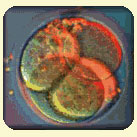

Preimplantaion Genetic Diagnosis (PGD)

The First Arizona PGD Baby is Born
Arizona’s first pre-implantation genetic diagnosis (PGD) baby was born at Northwest Hospital in Tucson on March 1st, 2004. It’s the most adorable baby boy. The baby’s parents would like to remain anonymous. The couple first visited Dr. Timothy Gelety at the Arizona Center for Reproductive Endocrinology and Infertility to undergo in-vitro fertilization (IVF) in June 2003. The successfully retrieved oocytes and sperm underwent in vitro fertilization and culture for three days to develope into embyos. On Day 3, one cell, called a blastomere, was carefully extracted from each pre-embryo. The blastomere were evaluated for any abnormal chromosomal development with fluorescent in-site hybridization (FISH) technology in which normal developing embryos can be identified. In the end, two normal male embryos were transferred into the uterus on the fifth day of development and two weeks later the patient was confirmed with a viable pregnancy after a single successful attempt.
PGD is used for determining the chromosomal health (PGD-FISH) or the presence or absence of specific genes related to a hereditary disease (PGD-PCR). When there is an incorrect number of chromosomes, or incorrect pairing of chromosomes, it can lead to early embryonic demise or result in conditions such as Down syndrome, Turner’s syndrome or Klinefelter’s syndrome. To check for normal chromosome pairing, we use a technique called fluorescent in situ hybridization (FISH).
PGD can also identify hereditary conditions are caused by gene disorders. Examples of these are cystic fibrosis, Duchnenne muscular dystrophy, Tay-Sachs disease, sickle cell anemia and X-chromosome linked disorders. To check for gene disorders, we use a technique called polymerase chain reaction (PCR). With this method, the genetic code contained in a single blastomere is greatly multiplied sot that the specific genes related to the disorder can be detected.
How PGD is Performed
PGD requires patients to undergo in vitro fertilization (IVF). After fertilization and culturing, one or two cells are removed from the pre-embryo. These cells, called blastomeres, are removed causing no harm to the pre-embryo. The blastomeres are evaluated and results are known in one to two days. In this way, PGD allows the embryologist to select only the normal pre-embyros fore transfer back into the patient’s uterus to establish pregnancy.

Who should use PGD?
PGD testing is recommended for couples who have a family history of an inherited disease or genetic disorder. It is also used for sex determination when there is the possibility of passing on an sex-linked disease. It is also a helpful tool for women who have had a history of unexplained miscarriage, or repeated failures with IVF.

During your patient consultation, we can discuss whether PGD is right for you.
Caring for you, Caring for your heath & Caring for your future
5190 E Farness Drive #114 Tucson, Arizona 85712
(520) 326-0001